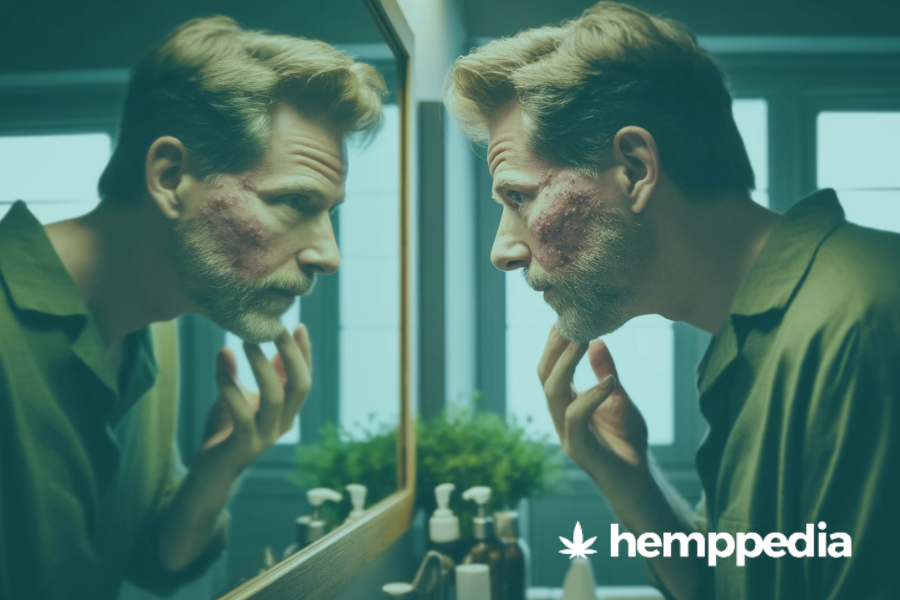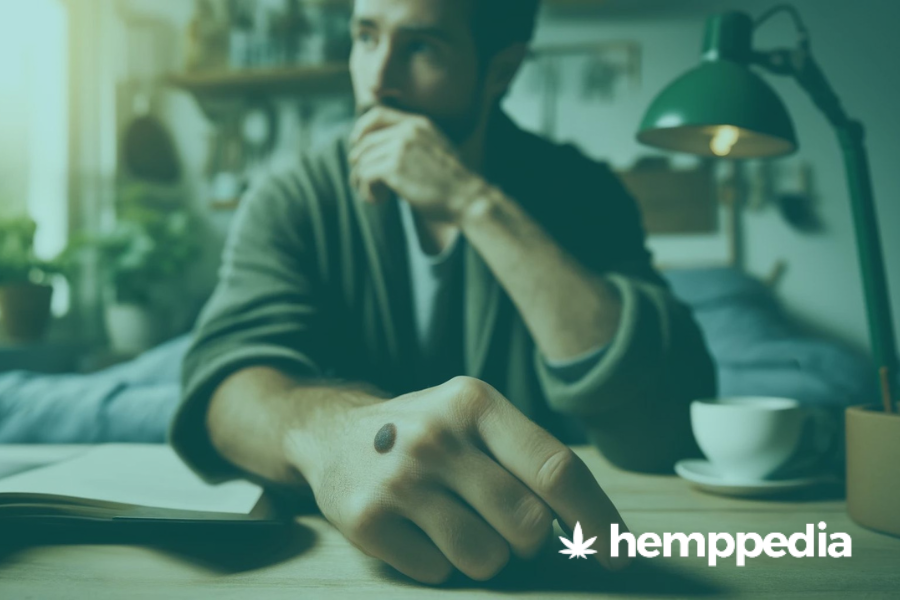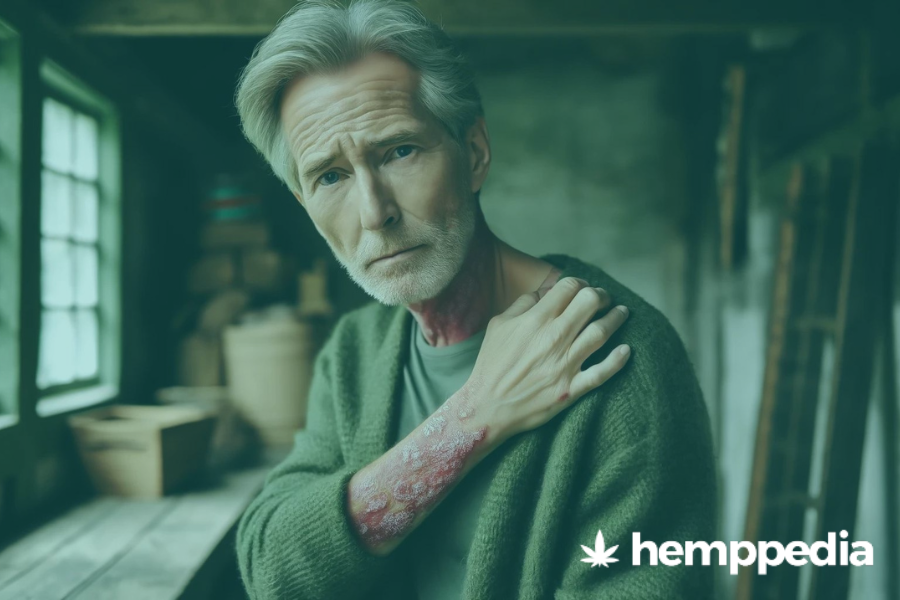Cannabidiol (CBD) can be a viable option for treating rosacea, a chronic skin disease characterised by inflammation of the skin in the central areas of the face1 Rosacea showing up as red blotches, bumps and rashes, and causing various sociopsychological problems in sufferers. There are many traditional treatments available for this condition, but there is no cure. However, interventions involving CBD and rosacea provide an alternative that has shown to offer a range of medical benefits. In this article we’ll explore these benefits, examine the best ways to take CBD and look at what the future holds for this natural cannabinoid.
What is Rosacea?
Rosacea is a chronic skin condition that causes facial flushing, a distinct redness that can affect central portions of the face2. If left untreated, the blood vessels in the skin can become further enlarged, exacerbating this redness and, in some cases, causing small, inflamed bumps to appear on the face, as well as watery eyes and itchy, dry skin. As the face is the most visible part of the body, sufferers of this condition have been known to experience – alongside physical discomfort – anxiety and self-esteem issues, which can lead to a reduced quality of life and social stigma.
Those who suffer from rosacea are often found in the 30 – 50 age range and, while men are more likely to experience a severe case of this condition, a greater number of women are affected. The direct causes of this condition are still being investigated, although experts say that the immune system may be partly to blame, while environmental factors such as stress, drugs, sun exposure and the weather have also been highlighted as contributing factors3.
Interestingly, rosacea appears to run in the family in roughly one-third of cases, suggesting that there may be a genetic susceptibility to this condition.
Conventional treatments for rosacea typically target the symptoms, but few attempt to tackle the underlying causes. The most common intervention is prescribed antibiotics – usually metronidazole – applied to the skin with a topical cream or taken orally. Steroid creams are also sometimes given to patients with this skin condition, but in both cases there may be adverse effects, including nausea, inflammation and hives. A more extreme intervention is the use of lasers to reduce the size of the blood vessels and, therefore, the redness of the skin.
Why CBD can be an effective treatment for Rosacea
CBD, a non-psychotropic chemical compound commonly derived from hemp, a type of cannabis plant, is known to have anti-inflammatory and anti-oxidant properties in humans. The reason CBD is able to produce these effects in the body is because we all have an in-built endocannabinoid system, a series of receptors throughout our physiology that respond to the presence of CBD, modulating the body’s internal systems in the process. If there is an imbalance in one of our systems – elevated stress hormone levels, for instance – then CBD will redress the balance and relieve the associated symptoms by inhibiting or enhancing the endocannabinoid receptors.
Interestingly, anxiety is one of the suspected triggers of rosacea, so the calming effects of CBD oil and rosacea may offer a way to temper these stress levels and reduce rosacea symptoms. Likewise, the immune system is suspected of playing a part in causing this skin condition as well. It is thought that microscopic mites found on the surface of the skin, and a type of bacteria in the gut known as helicobacter pylori, trigger the immune system to expand blood vessels and cause swelling and redness beneath the surface of the skin. The well-documented anti-inflammatory effects of CBD will help to combat these symptoms, as well as reduce the associated pain4. As previously mentioned, CBD also has anti-oxidant properties. Anti-oxidants protect our skin from the sun’s rays, which are known to exacerbate the presence of rosacea.
How To Use CBD for Rosacea
CBD oil can be taken in a variety of ways to treat an outbreak of rosacea:
Sublingual method
Oral method
Topical method
Unfortunately, there is not enough information out there to accurately determine which method of delivery is most effective for CBD oil and rosacea. Research on this subject in America was, until recently, illegal, so testing in this area is still in its infancy. However, a common way of taking this cannabinoid is by ingesting it, either by placing it under the tongue or taking it with food.
Taking CBD oil for rosacea with food may decrease its bioavailability – the rate and concentration levels at which it is absorbed into the bloodstream – while ingesting CBD on its own could have the opposite effect and reduce the levels of intake of the active ingredient. The digestive system’s enzymes will break down some of the CBD compounds into metabolites, therefore decreasing its concentration. This is why it is advised to place the CBD oil for rosacea under the tongue, where some of it can be absorbed and bypass the digestive system. Holding it for 1-2 minutes under the tongue before swallowing offers the best results with this method.
CBD for rosacea typically comes in a 30ml container with a dropper inside, and it can be mixed with other compounds for a combined effect, such as melatonin, a hormone for improving sleep regulation. The concentration levels of rosacea treatment with CBD will vary depending on the application, with some products containing 17mg of CBD per dropper at the lighter end of the scale, and full strength options rising to 84mg per dropper.
Using CBD for Rosacea on the Face
Applying CBD directly on the face an also help calm the condition. Drip a few drops of your favourite CBD oil on the face and gently rub them into the skin. Alternatively you can mix a few CBD oil drops with a face-balm or cream and appy the mixture as you would with a regular face cream.
What Is Medical Research Saying About Using CBD For Rosacea
While studies examining the efficacy of rosacea treatment with CBD are limited, there are various papers that show that the potential causes of this skin disease can be treated with CBD. One such paper review published on an authoritative dermatology site in 2018 examined the therapeutic potential of CBD and found that it can greatly reduce inflammation and immune system activity, with both being suspected causes of Rosacea according to experts.5
Likewise, a study conducted back in 2014, and published in The Journal of Clinical Investigation,6 discovered CBD’s anti-inflammatory benefits concerning acne, a condition that shares similar symptoms to rosacea. The clinical and lab study confirmed that CBD can reduce redness and discomfort in the skin together with a topical treatment of THC, paving the way for therapeutic interventions for rosacea.
Conclusion
CBD, as we have seen, offers a range of benefits for treating rosacea, from reducing symptoms such as inflammation and redness to tempering the immune system, a suspected direct cause of this chronic skin condition. To this end, CBD can be taken a variety of ways to treat rosacea, but consuming it with food or absorbing it under the tongue are thought to be the best methods. Research shows that CBD can help with known symptoms of rosacea, and more CBD and rosacea research will be conducted in the future thanks to more conducive regulations.7
References
- Tabassum, N. and Hamdani, M. (2014). Plants used to treat skin diseases. Pharmacognosy Reviews, 8(15), p.52. [↩]
- WebMD. (2019). What Is Rosacea?. [online] [↩]
- Mikkelsen, C., Holmgren, H., Kjellman, P., Heidenheim, M., Karppinnen, A., Bjerring, P. and Huldt-Nystrøm, T. (2016). Rosacea: a clinical review. Dermatology Reports, 8(1). [↩]
- Costa, B., Colleoni, M., Conti, S., Parolaro, D., Franke, C., Trovato, A. and Giagnoni, G. (2004). Oral anti-inflammatory activity of cannabidiol, a non-psychotropic constituent of cannabis, in acute carrageenan-induced inflammation in the rat paw. Naunyn-Schmiedeberg’s Archives of Pharmacology, 369(3), pp.294-299. [↩]
- Marks, D. and Friedman, A. (2018). The Therapeutic Potential of Cannabinoids in Dermatology. Skin Therapy Letter, 23(6). [↩]
- Oláh, A., Tóth, B. I., Borbíró, I., Sugawara, K., Szöllõsi, A. G., Czifra, G., … & Ludovici, M. (2014). Cannabidiol exerts sebostatic and antiinflammatory effects on human sebocytes. The Journal of clinical investigation, 124(9), 3713-3724. [↩]
- Oláh, A., Tóth, B., Borbíró, I., Sugawara, K., Szöllõsi, A., Czifra, G., Pál, B., Ambrus, L., Kloepper, J., Camera, E., Ludovici, M., Picardo, M., Voets, T., Zouboulis, C., Paus, R. and Bíró, T. (2014). Cannabidiol exerts sebostatic and antiinflammatory effects on human sebocytes. Journal of Clinical Investigation, 124(9), pp.3713-3724. [↩]




